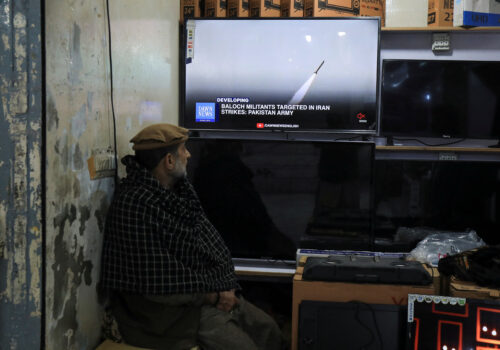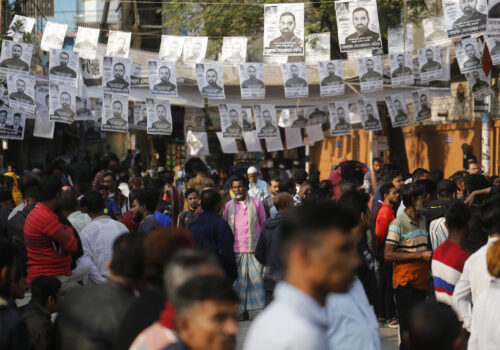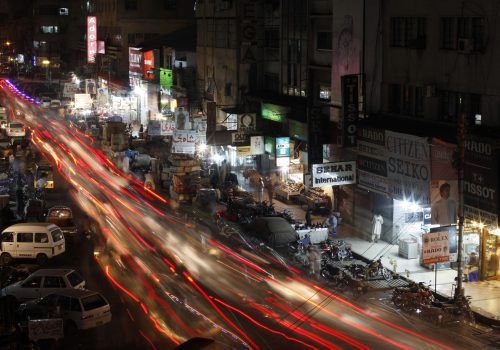The skies are quiet, but the Iran-Pakistan strikes left lasting diplomatic damage
Pakistan-Iran relations nosedived sharply on January 16, when Tehran carried out unilateral strikes in western Pakistan, following its recent attacks in Iraq and Syria. In turn, Pakistan adopted a two-stage strategy: First, it downgraded diplomatic ties with Tehran by recalling its ambassador. Then, forty-eight-hours after the attack, it conducted retaliatory strikes inside southeastern Iran, targeting what it described as terrorist hideouts. Several tense days followed, and then Iran and Pakistan announced on Monday that they would return their envoys and Iranian Foreign Minister Hossein Amir-Abdollahian would visit Islamabad next week.
With their strikes, Pakistan and Iran targeted different Baloch-led militant groups along their shared border. The latest tit-for-tat military strikes, however, must also be seen against the backdrop of widening regional conflict in the Middle East as US-led forces attack Iranian-backed Houthis in Yemen. While Iran’s proxy conflict with Israel and the United States has escalated in recent weeks, Pakistan faces a new external challenge: How should it navigate relations with its Persian neighbor while supporting regional stability?
The strikes last week will alter regional dynamics with a long-term impact on bilateral ties between Islamabad and Tehran. While the immediate crisis will subside, an intensified security dilemma will be permanent for Pakistan. Pakistan is already navigating difficult ties with India and Afghanistan, its two main neighbors. Now, Pakistan is inevitably compelled to review its overall relationship with Iran and seek a new modus operandi, both bilaterally and in the region. This will include reviewing its existing defense posture on its border with Iran, establishing new patterns of regional engagement, and reassessing trade and other interactions between the two sides.
Rethinking border security
For starters, Pakistan’s defense planners now must examine their existing posture along the country’s southwestern border and throughout the Balochistan province. Now security managers will have to consider a renewed Iranian inclination to act across the border when dealing with separatist groups active in Balochistan. This will demand evaluating the current defensive posture and, where necessary, beefing it up with additional aerial reconnaissance drones, air-defense assets, artillery vehicles, and long-range rockets. Islamabad will be cognizant that military planners in Tehran are also reviewing Pakistan’s retaliatory strikes and reconsidering Iran’s defense posture along their country’s border with Pakistan.
Diplomatically, Pakistan is now poised to take advantage of strategic opportunities provided by Iran. Pakistan has an opportunity, for example, to be a swing state in the wider Persian Gulf and Arabian Sea region that can take advantage of great powers’ interest toward “nearshoring” and “friendshoring.” Islamabad could increase political engagement with Tehran’s regional competitors and the United States on regional security in the Gulf and Strait of Hormuz. Capitals in the region and beyond have already taken note of Pakistan’s strikes inside Iran—the first time in more than three decades that a country has conducted missile strikes inside Iran. While Pakistan had no option but to respond, this exchange has opened space for new conversations on regional stability and enhanced maritime security cooperation in the western Indian Ocean region with Gulf states and the United States.
Meanwhile, countries such as China and Turkey are likely to continue to focus on defusing tensions and reviving communication channels between Pakistan and Iran to address their respective concerns. Islamabad will be cognizant of Beijing’s concerns about the security of its citizens in Gwadar, a major port city near the Iranian border where China has launched infrastructure and connectivity projects.
With Russia, however, Pakistan’s regional convergence may have peaked. Pakistan-Russia relations grew in recent years out of both countries’ involvement in Afghanistan, but their influence over the current Afghan regime is much more limited. Additionally, Islamabad and Moscow previously used their engagement to signal to (and to hedge against closer cooperation between) New Delhi and Washington. Recent diplomatic shifts, including some diplomatic fallout from then Pakistani Prime Minister Imran Khan visiting Moscow as Russia started its full-scale invasion of Ukraine, have reduced the signaling effectiveness of greater Pakistan-Russia engagement.
Even still, many in Pakistan’s strategic community had envisioned a Russia-Iran-China-Pakistan axis to balance Washington’s posture across the Middle East and South Asia. Increased Pakistan-Iran tensions could work against this trend, too. If the United States, as a result of ongoing turmoil in the Middle East, expands it engagement and military footprint in the wider region, then Islamabad may seek even greater engagement with Washington as a signal to Tehran. That will then put Pakistan in a position of navigating the competing interests of the United States and China, the latter of which has increased its engagement in the region in recent years but will want to keep friendly relations with Iran.
Beyond regional politics, cross-border militancy will now again be at the forefront of the Pakistan-Iran relationship. In reciprocal strikes, both sides claimed to target hideouts of specific militant groups they hold responsible for attacks on their forces and citizens. The people inhabiting Pakistan-Iran borderlands are no stranger to violence by both state and militant groups. China has been active in bringing Iran and Pakistan together to discuss counterterrorism concerns and cooperation. That Iran chose to unilaterally strike, instead of seeking coordinated action, underscores the limitations of trilateral and bilateral cooperation to address this ongoing irritant for Islamabad-Tehran ties. From here onwards, despite vows of defusing tensions, Pakistan needs to prepare for renewed instability in Balochistan, as the current crisis has demonstrated to Baloch separatist groups and to the militant group Jaish al-Adl that they can provoke an inter-state crisis, with wider regional implications.
Trade ties that bind
Pakistan’s crucial vulnerability with Iran, however, is its dependence on high-volume informal trade, which sustains the populace in border regions and across Balochistan. Formally, seven border markets are now operational to facilitate barter trade between people from both sides. Informal trade, however, dominates. Pakistan’s Makran region is particularly dependent on supplies of food, petroleum products, and electricity from Iran. Some products also make their way to Karachi and as far as Islamabad. Iranian diesel is smuggled across the border on blue Zamyad pickup trucks, which are easily spotted across Balochistan. Makran division and the border districts are connected more to Iran’s economy than to Pakistan’s. These relatively cheaper goods—since no duties or taxes are levied—are crucial to fight inflationary pressures across Balochistan and in cities elsewhere. This economic activity, however, is complicated by illicit drug trafficking facilitated by different militant groups through overland and maritime routes, with the region serving as a gateway to Turkey and Europe on one side and South Asia on the other.
Taken together, these economic activities are massive. Based on an estimate derived from data on smuggled gasoline and diesel in a 2020 inquiry commission report, informal Iran-Pakistan trade could surpass three billion dollars per year, while official data put formal trade at two billion dollars per year. Islamabad’s challenge, thus, is to ensure the economic needs of the local populace are sufficiently met as it prepares for an uneasy relationship with Tehran where arbitrary curbs on informal trade could be applied by each side to gain leverage. This challenge is only compounded by already strained border trade with Afghanistan, where Pakistan is trying to set new parameters of bilateral engagement.
These external challenges are mounting while Pakistan is in the midst of an election campaign. When the new government enters office in a few weeks, it will confront a new reality of eroding trust with Iran. It’s worth remembering that Pakistan withstood pressure from its traditional Gulf partners (the United Arab Emirates and Saudi Arabia) for refusing to contribute troops to fight against the Iranian-backed Houthis in Yemen in 2015. Despite divergent regional interests, successive governments maintained steady engagement with Iran. Even military ties picked up steam with regular visits and naval exercises, with one taking place on the day Iran attacked inside Pakistan. Islamabad’s proactive balancing effort has been undermined, and repairing this relationship would require concerted efforts from Iran, as Pakistan has learned that its third border has become a potential military zone with long-term impacts on the country’s internal and external security calculus.
Muhammad Faisal is a PhD candidate in international relations at the University of Technology Sydney.
Further reading
Thu, Jan 18, 2024
Experts react: What’s really going on with Pakistan and Iran exchanging attacks?
New Atlanticist By
Pakistan just conducted airstrikes in southeastern Iran, two days after Iran used missiles and drones to strike western Pakistan. Atlantic Council experts explain what’s going on.
Thu, Jan 18, 2024
What Bangladesh’s widely boycotted election reveals about its future
New Atlanticist By Ali Riaz
The election results were a foregone conclusion, as there were no opposition parties contesting. But the results reveal a deeper entrenchment of Prime Minister Sheikh Hasina’s party.
Fri, Nov 3, 2023
Pakistan’s long journey toward sustainable growth requires timely, free, and fair elections
New Atlanticist By Uzair Younus
Elections should be followed by a transparent, consensus-driven process that devolves power to the grassroots level through functional local governments.
Image: A man looks at a television screen after the Pakistani foreign ministry said the country conducted strikes inside Iran targeting separatist militants, two days after Tehran said it attacked Israel-linked militant bases inside Pakistani territory, in Karachi, Pakistan January 18, 2024. REUTERS/Akhtar Soomro


